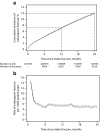Risk of imminent fracture following a previous fracture in a Swedish database study
- PMID: 30680431
- PMCID: PMC6422949
- DOI: 10.1007/s00198-019-04852-8
Risk of imminent fracture following a previous fracture in a Swedish database study
Abstract
This study examined the imminent risk of a future fracture within 1 and 2 years following a first fracture in women aged 50 years and older and assessed independent factors associated with risk of subsequent fractures. The study highlights the need to intervene rapidly after a fracture to prevent further fractures.
Introduction: This study aims to determine the imminent risk of subsequent fractures within 1 and 2 years following a first fracture and to assess independent factors associated with subsequent fractures.
Methods: Retrospective, observational cohort study of women aged ≥ 50 years with a fragility fracture was identified from Swedish national registers. Clinical/demographic characteristics at the time of index fracture and cumulative fracture incidences up to 12 and 24 months following index fracture were calculated. Risk factors for subsequent fracture were identified using multivariate regression analysis.
Results: Two hundred forty-two thousand one hundred eight women (mean [SD] age 74 [12.5] years) were included. The cumulative subsequent fracture incidence at 12 months was 7.1% (95% confidence interval [CI], 6.9-7.2) and at 24 months was 12.0% (95% CI, 11.8-12.1). The rate of subsequent fractures was highest in the first month (~ 15 fractures per 1000 patient-years) and remained steady between 4 and 24 months (~ 5 fractures/1000 patient-years). Higher age was an independent risk factor for imminent subsequent fractures (at 24 months, sub-distribution hazard ratio [HR], 3.07; p < 0.001 for women 80-89 years [reference 50-59 years]). Index vertebral fracture was a strong independent risk factor for subsequent fracture (sub-distribution HR, 2.72 versus hip fracture; p < 0.001 over 12 months; HR, 2.23; p < 0.001 over 24 months).
Conclusions: Our findings highlight the need to intervene rapidly after any fragility fracture in postmenopausal women. The occurrence of a fragility fracture provides healthcare systems with a unique opportunity to intervene to reduce the increased risk of subsequent fractures.
Keywords: Fracture risk; Fragility fracture; Near-term; Osteoporosis.
Conflict of interest statement
Ethical approval
The study has been approved by the Regional Ethical Review Board in Stockholm and performed in accordance with the ethical standards as laid down in the 1964 Declaration of Helsinki and its later amendments. For this type of study, individual formal consent was not required.
Conflicts of interest
JB, LK, OS, and GO are employed by Quantify Research, and Quantify Research was funded by UCB Pharma to conduct this study.
KEA has received lecture fees from Merck, UCB Pharma, Eli Lilly, Amgen, and Novartis.
AS has received lecture fees from Amgen and Eli Lilly.
OL has received lecture fees from Eli Lilly and Amgen.
CL and ET are employed by, and own stocks in, UCB Pharma.
Figures

References
-
- Hernlund E, Svedbom A, Ivergård M, Compston J, Cooper C, Stenmark J, McCloskey EV, Jönsson B, Kanis JA. Osteoporosis in the European Union: medical management, epidemiology and economic burden. A report prepared in collaboration with the international Osteoporosis Foundation (IOF) and the European Federation of Pharmaceutical Industry Associations (EFPIA) Arch Osteoporos. 2013;8:136. doi: 10.1007/s11657-013-0136-1. - DOI - PMC - PubMed
-
- Bentler SE, Liu L, Obrizan M, Cook EA, Wright KB, Geweke JF, Chrischilles EA, Pavlik CE, Wallace RB, Ohsfeldt RL, Jones MP, Rosenthal GE, Wolinsky FD. The aftermath of hip fracture: discharge placement, functional status change, and mortality. Am J Epidemiol. 2009;170:1290–1299. doi: 10.1093/aje/kwp266. - DOI - PMC - PubMed

